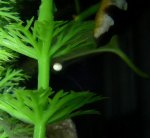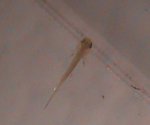Spectacled90
New member
- Joined
- Oct 22, 2008
- Messages
- 7
- Reaction score
- 0
- Points
- 0
- Country
- Italy
Hi!
This is my first attempt to breed Neurergus kaiseri and the result seems very promising!!

I stabulated my newts in a semi-terrestrial setup with a small part of water 5-6 cm deep for 50 days at 3-13 °C.
On the first of January I put them in a heated aquarium (60 liters) with water temperature between 19-23°C.
I saw courtship behaviour only early in the morning, when the aquarium light wasn't on.
Egg-laying started on 16th January and up to now the female layed over 80 eggs!!!
Thanks to Alan for his precious suggestions!!!
Some pics of the first eggs:
This is my first attempt to breed Neurergus kaiseri and the result seems very promising!!
I stabulated my newts in a semi-terrestrial setup with a small part of water 5-6 cm deep for 50 days at 3-13 °C.
On the first of January I put them in a heated aquarium (60 liters) with water temperature between 19-23°C.
I saw courtship behaviour only early in the morning, when the aquarium light wasn't on.
Egg-laying started on 16th January and up to now the female layed over 80 eggs!!!
Thanks to Alan for his precious suggestions!!!
Some pics of the first eggs:







